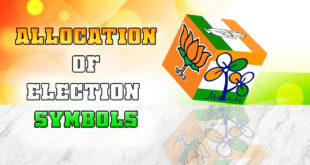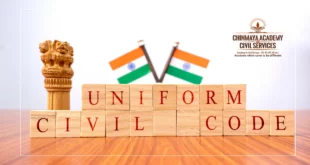- The Chief Justice of India, D. Y. Chandrachud compared the ‘basic structure’ of the Constitution to the North Star, an unfailing guide which shows the way when the path appears convoluted.
- His observation marks the response of the Supreme Court to a recent statement made by Vice President Jagdeep Dhankar that the basic structure doctrine introduced by a 13-judge Bench 40 years ago, in the Kesavananda Bharati Sripadagalvaru versus State of Kerala through a 7:6 wafer-thin majority judgment, diluted parliamentary sovereignty.
- The opinion of the Vice President and the reply from the top judge have come amidst an ongoing verbal skirmish initiated by the government over the striking down of the 99th Constitutional Amendment and the National Judicial Appointments Commission (NJAC) Act in a 4:1 majority decision of the Supreme Court in October 2015.
- The government is now vying, after a gap of nearly eight years, for a stronger, if not dominant, spot in judicial appointments to constitutional courts.
- It remains bitter about the failure of the NJAC, a constitutional amendment, it said, was an exercise of the “will of the people” through Parliament.
- At the heart of both the Kesavananda Bharati case, better known as the Fundamental Rights case, and the current debate over the Collegium, a powerful body of Supreme Court judges which recommends names for judicial appointments, is a fundamental question — does Parliament have unlimited power to amend the Constitution or is it subject to inherent limitations
The basic structure doctrine
- The Kesavananda Bharati judgment held that Parliament cannot use its constituent power to alter the basic structure or the essential features of the Constitution.
- The Parliament, as senior advocate Nani Palkhivala said (at whose memorial lecture Chief Justice Chandrachud gave his reply) cannot cease to be a creature of the Constitution and become its master.
- The basic structure or framework of the Constitution is its living spirit, holding up the body of its text. Its existence cannot be pin-pointed to any particular provision of the text.
- It is the “soul” of the Constitution, inextricably linked to the values enshrined in the Preamble, without which the document and the ideas that make it sacred would collapse. “A Constitution is a living system.
- But just as in a living, organic system, such as the human body, [where] various organs develop and decay, yet the basic structure or pattern remains the same with each of the organs having its proper function, so also in a Constitutional system the basic institutional pattern remains even though the different component parts may undergo significant alterations.
- For it is the characteristic of a system that it perishes when one of its essential component parts is destroyed,” the Supreme Court explained in the 703-page Kesavananda Bharati verdict of April 24, 1973.
- Granville Austin’s Working of a Democratic Constitution said the basic structure doctrine “is fairly said to have become the bedrock of constitutional interpretation in India”.
- The Constitution Bench in the NJAC judgment encapsulated the principle behind the basic structure theory when it said “a change in a thing does not involve its destruction”.
- Different judges on the Kesavananda Bharati Bench gave different examples of what constituted the ‘basic structure’ of the Constitution, including supremacy; the federal and secular character of the Constitution; separation of powers among the legislature, executive and judiciary; dignity of the individual; unity and integrity of the nation; sovereignty of India; democratic character of our policy; welfare state and egalitarian society; liberty of thought, expression, belief, faith and worship and equality of status and opportunity among other essential features.
The Kesavananda Bharati case
- Justice O. Chinnappa Reddy in his The Court and the Constitution of India: Summits and Shallows says Chief Justice S. M. Sikri, who led the Kesavananda Bharati Bench, never divulged from where he derived the basic structure formula.
- “Since there are no signposts signalling basic features of the Constitution, every attempt to discover a basic feature becomes a ‘voyage of discovery’,” Justice Reddy wrote.
- The Kesavananda Bharati case came to the Supreme Court almost immediately after the Indira Gandhi government rode to victory in the 1971 elections on the popular slogan of ‘garibi hatao’ with almost 350 seats out of a total of 540.
- The government, smarting primarily under the Supreme Court’s Golak Nath verdict which upheld the power of judicial review of constitutional amendments, introduced several Constitutional Amendments.
- The 24th Constitutional Amendment changed Article 13, a provision which mandated that no ‘law’ could take away or abridge fundamental rights.
- The Golak Nath judgment had interpreted the term ‘law’ in Article 13(2) to include ‘constitutional amendments’ too.
- The Parliament through the 24th Amendment said a constitutional amendment cannot be rendered void merely because it infringed fundamental rights.
- It also modified Article 368, a provision which dealt with constitutional amendments, to enable the Parliament to add, vary or repeal any Article of the Constitution.
- The 13-judge Bench upheld the Parliament’s power to amend the Constitution as long as it adhered to its basic structure or essential features.
- The 25th Constitutional Amendment introduced Article 31C into the Constitution to implement the Directive Principles of State Policy under Article 39 (b) and (c) for distribution of material resources of the community and to prevent concentration of wealth.
- The government’s aim was to facilitate nationalisation of industries and socialist measures. The Amendment mandated that any law enacted with this objective cannot be “deemed” void on the ground that it was inconsistent with fundamental rights.
- The latter half of Article 31C added that such a law would be outside judicial review. In fact, even a petition cannot be filed in court challenging such a law.
- In short, the Amendment gave Directive Principles primacy over fundamental rights and judicial review of the apex court.
- Senior advocates Soli Sorabjee and Arvind Datar in their Nani Palkhivala — The Courtroom Genius described the great lawyer arguing that Article 31C was the “forerunner of a totalitarian State’.
- The 13-judge Bench invalidated the part of Article 31C which took away the power of judicial review of the court.
- However, the Kesavananda Bharati judgment gave no relief to the petitioner-seer when it upheld the 29th Constitutional Amendment which incorporated two land reform provisions made in the Kerala Land Reforms Act, 1963 in the Ninth Schedule, immunising them from litigation claiming violation of fundamental rights. A fourth constitutional amendment, the 26th, on abolition of privy purses, was not considered by the Court.
The (counter) arguments
- Sorabjee and Mr. Datar, in their book, condense the submissions of the Union and the States, represented by senior advocate H. M. Seervai and then Attorney General Niren De, that constitutional amendments should not be nullified by the court as they mirror the “democratic will of the people”.
- An argument which has surfaced again through Mr. Dhankar after four decades. But Mr. Palkhivala had met this argument with a prescient one of his own, “people are not associated with the amending process at all. Parliament cannot be equated with the people, the Parliament’s will is not the people’s will”.
The aftermath
- The judgment was delivered on the last working day of Chief Justice Sikri. Justice A.N. Ray, the fourth in line of seniority and who was part of the minority which upheld the unlimited power of Parliament to amend the Constitution, superseded Justices J. M. Shelat, K.S. Hegde and A. N. Grover to become the 14th Chief Justice of India.
- All three of his colleagues resigned. A similar supersession followed when Justice H. R. Khanna, after his lone but historic dissent upholding the fundamental right to life and personal liberty in the Habeas Corpus case during the darkest days of Emergency, was overlooked for Chief Justiceship.
- These incidents could be directly linked to the Supreme Court evolving the Collegium system to protect judicial independence, which is also part of the basic structure doctrine.
- The basic structure doctrine had survived an aborted attempt to overrule the Kesavananda Bharati judgment by another 13-member Bench led by Chief Justice Ray.
- It came in handy when the court, in the Indira Gandhi versus Raj Narain case, removed the 39th Constitutional Amendment passed during the Emergency period which put the elections of the President, Vice President, Prime Minister and Lok Sabha Speaker beyond judicial review.
- In 1980, the court once again used the basic structure formula, in the Minerva Mills challenge to the 42nd Amendment, to uphold judicial review of constitutional amendments and to protect fundamental rights.
- Over the years, the courts have clarified the basic structure, including that of the “primacy to the opinion of the Chief Justice of India in judicial appointments and transfers in the context of the independence of the judiciary as a part of the basic structure of the Constitution to secure the rule of law essential for preservation of the democratic system”.
SOURCE: THE HINDU, THE ECONOMIC TIMES, PIB
 Chinmaya IAS Academy – Current Affairs Chinmaya IAS Academy – Current Affairs
Chinmaya IAS Academy – Current Affairs Chinmaya IAS Academy – Current Affairs



